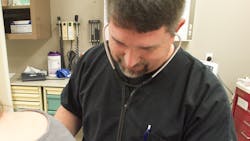CDC updates criteria for return to work for healthcare personnel with suspected or confirmed COVID-19
This Centers for Disease Control and Prevention (CDC) has updated its interim guidance for occupational health programs and public health officials making decisions about return to work for healthcare personnel (HCP) with confirmed COVID-19, or who have suspected COVID-19 (e.g., developed symptoms of a respiratory infection [e.g., cough, sore throat, shortness of breath, fever] but did not get tested for COVID-19).
Decisions about return to work for HCP with confirmed or suspected COVID-19 should be made in the context of local circumstances. Options include a symptom-based (i.e., time-since-illness-onset and time-since-recovery strategy) or time-based strategy or a test-based strategy. Of note, there have been reports of prolonged detection of RNA without direct correlation to viral culture.
A summary of recent changes as of April 30, 2020 includes:
- Changed the name of the ‘non-test-based strategy’ to the ‘symptom-based strategy’ for those with symptoms and the ‘time-based strategy’ for those without symptoms, and updated these to extend the duration of exclusion from work to at least 10 days since symptoms first appeared. This update was made based on evidence suggesting a longer duration of culturable viral shedding and will be revised as additional evidence becomes available.
- Based on this extension of the symptom-based and time-based strategies, language about the test-based strategy being preferred was removed.
- Removed specifying use of nasopharyngeal swab collection for the Test-Based Strategy and linked to the Interim Guidelines for Collecting, Handling, and Testing Clinical Specimens for 2019 Novel Coronavirus (2019-nCoV), so that the most current specimen collection strategies are recommended.
- Symptom-based strategy. Exclude from work until:
- At least three days (72 hours) have passed since recovery defined as resolution of fever without the use of fever-reducing medications and improvement in respiratory symptoms (e.g., cough, shortness of breath); and,
- At least 10 days have passed since symptoms first appeared
- Test-based strategy. Exclude from work until:
- Resolution of fever without the use of fever-reducing medications and
- Improvement in respiratory symptoms (e.g., cough, shortness of breath), and
- Negative results of an FDA Emergency Use Authorized COVID-19 molecular assay for detection of SARS-CoV-2 RNA from at least two consecutive respiratory specimens collected ≥24 hours apart (total of two negative specimens). See Interim Guidelines for Collecting, Handling, and Testing Clinical Specimens for 2019 Novel Coronavirus (2019-nCoV). Of note, there have been reports of prolonged detection of RNA without direct correlation to viral culture.
- Time-based strategy. Exclude from work until:
- 10 days have passed since the date of their first positive COVID-19 diagnostic test assuming they have not subsequently developed symptoms since their positive test. If they develop symptoms, then the symptom-based or test-based strategy should be used. Note, because symptoms cannot be used to gauge where these individuals are in the course of their illness, it is possible that the duration of viral shedding could be longer or shorter than 10 days after their first positive test.
- Test-based strategy. Exclude from work until:
- Negative results of an FDA Emergency Use Authorized COVID-19 molecular assay for detection of SARS-CoV-2 RNA from at least two consecutive respiratory specimens collected ≥24 hours apart (total of two negative specimens). Note, because of the absence of symptoms, it is not possible to gauge where these individuals are in the course of their illness. There have been reports of prolonged detection of RNA without direct correlation to viral culture.
Note that detecting viral RNA via PCR does not necessarily mean that infectious virus is present. Consider consulting with local infectious disease experts when making return to work decisions for individuals who might remain infectious longer than 10 days (e.g., severely immunocompromised). If HCP had COVID-19 ruled out and have an alternate diagnosis (e.g., tested positive for influenza), criteria for return to work should be based on that diagnosis.
Return to Work Practices and Work Restrictions:
- Wear a facemask for source control at all times while in the healthcare facility until all symptoms are completely resolved or at baseline. A facemask instead of a cloth face covering should be used by these HCP for source control during this time period while in the facility. After this time period, these HCP should revert to their facility policy regarding universal source control during the pandemic.
- A facemask for source control does not replace the need to wear an N95 or higher-level respirator (or other recommended PPE) when indicated, including when caring for patients with suspected or confirmed COVID-19.
- Of note, N95 or other respirators with an exhaust valve might not provide source control.
- Self-monitor for symptoms, and seek re-evaluation from occupational health if respiratory symptoms recur or worsen
Strategies to Mitigate Healthcare Personnel Staffing Shortages:
Maintaining appropriate staffing in healthcare facilities is essential to providing a safe work environment for HCP and safe patient care. As the COVID-19 pandemic progresses, staffing shortages will likely occur due to HCP exposures, illness, or need to care for family members at home. Healthcare facilities must be prepared for potential staffing shortages and have plans and processes in place to mitigate them, including considerations for permitting HCP to return to work without meeting all return to work criteria above.
Refer to the Strategies to Mitigate Healthcare Personnel Staffing Shortages document for information. As part of this, asymptomatic HCP with a recognized COVID-19 exposure might be permitted to work in a crisis capacity strategy to address staffing shortages if they wear a facemask for source control for 14 days after the exposure. This time period is based on the current incubation period for COVID-19 which is 14 days.
